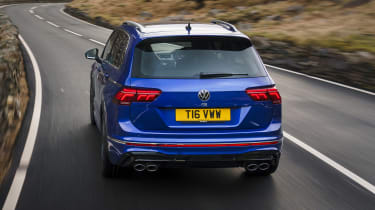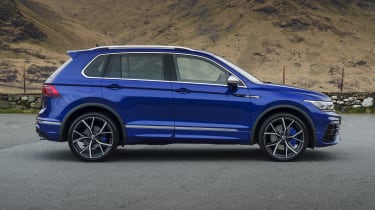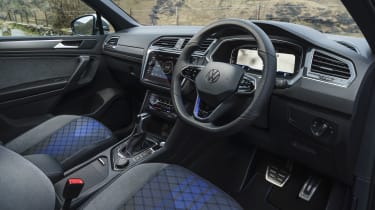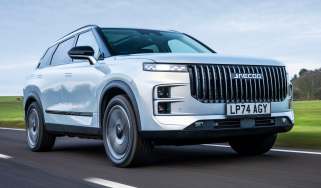Volkswagen Tiguan R SUV review
“The hot Volkswagen Tiguan R is certainly quick but a Golf R is more rewarding to drive”
Pros
- Accessible performance
- Well-equipped
- Practical
Cons
- Unsettled ride
- Poor fuel economy
- Not very rewarding to drive
Performance SUVs are gaining in popularity and Volkswagen is trying its best to take advantage. It already sells the Volkswagen T-Roc R and the VW Group provides parts and underpinnings for the Cupra Ateca, Cupra Formentor, Skoda Kodiaq vRS and a whole host of fast Audi SUVs. In 2021, Volkswagen also introduced the Tiguan R you see here and a plug-in hybrid Touareg R, not to mention new GTX versions of the electric ID.4 and ID.5. With the exception of the smaller T-Cross and Taigo crossovers, every VW SUV has a performance option.
That means that despite ever-tightening emissions regulations, the sensible Volkswagen Tiguan is now available with a 316bhp petrol engine and a 0-62mph time of under five seconds. It shares its engine and underpinnings with the Volkswagen Golf R, albeit not quite the same driving experience.
 Top 10 best sports and performance SUVs 2025
Top 10 best sports and performance SUVs 2025
As you sit higher, you don’t feel quite so involved in the action. The Tiguan R is undeniably fast but it feels slow to change direction and rather muted compared to the Golf R. The ride is firm, as you’d expect with such big wheels and a sports suspension, and the car never feels settled.
Owning a Tiguan R will also require frequent visits to petrol pumps, as the car isn’t economical with fuel. There’s also a large tax bill to consider, while consumables will be more expensive than they are for lesser versions of the Tiguan.
If you can live with the Tiguan R’s thirst for petrol and the slightly numb driving experience, then the car does excel elsewhere. Four-wheel drive means it has plenty of grip, which will be a comfort in winter. The spacious interior and massive boot means it’s as focused on practicality as performance, while there’s a good level of standard equipment.
More reviews
Based on the existing Tiguan R-Line, the R has heated seats, LED headlights, sat nav and a digital instrument cluster as standard. The very latest safety features are fitted too.
Perhaps VW’s biggest challenge with the Tiguan R is that its price pushes it very close to some other very desirable SUVs. The Porsche Macan and Alfa Romeo Stelvio Veloce aren’t much more expensive, especially on a monthly basis, while you’ve got to pay more for the Tiguan than for the Cupra Ateca or MINI Countryman JCW.
MPG, running costs & CO2
The ordinary Tiguan can be quite frugal but that’s not the case with the range-topping Tiguan R. With four-wheel drive, 316bhp and an automatic gearbox, the car was never likely to be particularly economical but an official figure of 28.2mpg is still poor, and you’ll get nowhere near that if you use the engine’s power. Most fast SUVs will at least crack 30mpg on a cruise.
The Tiguan R is also quite expensive to buy, costing around £46,000 before options. As such, it’s subject to a near-£500 annual VED (road tax) bill until the sixth time you renew, at which point it’ll drop to the standard rate. Company-car drivers looking at a Tiguan R will pay the highest rate of BiK tax. Like any other Tiguan, the R comes with a three-year/60,000-mile warranty.
Engines, drive & performance
It’s a little surprising that the Tiguan R hasn’t come sooner because so many of the components have been used already. It gets the same 316bhp 2.0-litre engine as the Golf R, as well as its seven-speed automatic gearbox and four-wheel-drive system. The 4MOTION system doesn’t allow the Tiguan R to cross inhospitable terrain but it does make the car quicker off the line. Zero-to-62mph can take as little as 4.9 seconds.
If only the Tiguan R felt as fast as the stats suggest. It goes very quickly in a straight line but you feel a little detached from the speed and the entire experience isn’t hugely involving. Buyers switching from a Golf R are likely to feel somewhat disappointed.
The steering is precise but the Tiguan R feels less keen on quick direction changes than the Golf R. Volkswagen has firmed up the suspension to improve the Tiguan’s dynamic but the downside is that the car is jiggly and uncomfortable on all but the very smoothest road surfaces. This isn’t helped by the huge 21-inch alloy wheels.
The four-wheel-drive system ensures there’s always plenty of traction, while it also improves stability too. As a result, the Tiguan feels secure, which is bound to appeal to buyers with families or those who live in rural areas.
You can add an Akrapovic titanium sports exhaust from the options list to make the car sound more exciting but it costs more than £3,000.
Interior & comfort
It’s fair to say that the Volkswagen Tiguan doesn’t have the most radical dashboard but the R does at least add a few exclusive touches to elevate it above cheaper models. Blue highlights feature on the steering wheel and on the R-specific seats, and the digital instrument cluster gains unique graphics.
Some of the driving modes pipe artificial engine noise through the speakers but this isn’t really needed; in Pure mode you can still hear the engine and a few characterful pops when the gearbox changes down.
With the R’s range-topping status comes a reasonable array of equipment. The highlights include three-zone air conditioning, heated front seats, sat nav, 30-colour ambient lighting, LED headlights and a heated steering wheel. Despite this, there are still plenty of options you can pick, such as a panoramic sunroof, leather upholstery and a head-up display.
Practicality & boot space
It may seem odd to create a performance model out of a big, boxy SUV, but the result is a car that is both sporty and practical. There’s a lot of space in the rear seats, so six-footers can sit behind each other, and the back seats can slide forwards to allow you to prioritise passenger or boot space. The Tiguan has you covered for lots of little odds and ends too; there are big door pockets, a large central storage compartment and a cubby on top of the dash, each lined with rubber or fabric to stop items rattling around.
The Tiguan’s boot is 615 litres, which seems unaffected by the addition of the 4MOTION four-wheel-drive system. The Tiguan offers more boot space than the Cupra Ateca and usefully more space than the smaller T-Roc R and Audi SQ2. When the seats are pushed all the way back, the space on offer is a still-generous 520 litres. Handily, each seat folds individually.
Reliability & safety
The Tiguan R won’t be individually tested by Euro NCAP as it’ll share the rating given to the standard Tiguan. Fortunately, that car gets a five-star score, with 96% and 84% for adult and child protection respectively. As the top-of-the-range Tiguan, the R gets plenty of safety features, including road sign display, travel assist (combining lane-keeping assistance and adaptive cruise control), self-parking ability and a proactive passenger protection system that senses if you’re about to have a crash.
In our 2021 Driver Power owner satisfaction survey, the Tiguan came 62nd in our list of the top 75 cars. It was praised for its practicality but Volkswagen’s big-selling SUV didn’t impress in many other areas. Fuel consumption was rated poor and that’ll certainly be the case in the Tiguan R. Just over 15% of Volkswagen owners reported a fault within the first year of ownership, while the brand itself finished midtable in our best brands list.


















